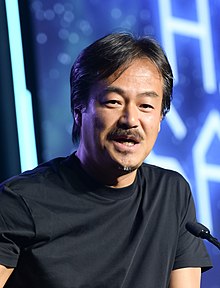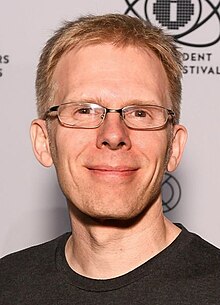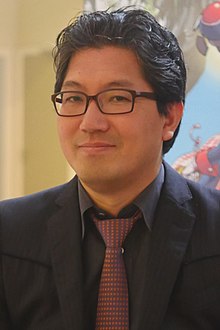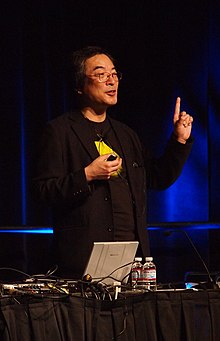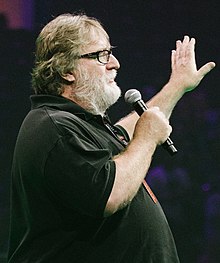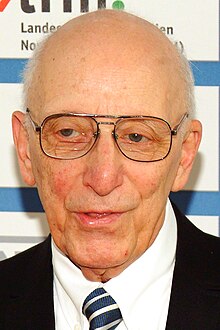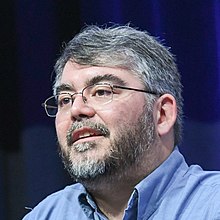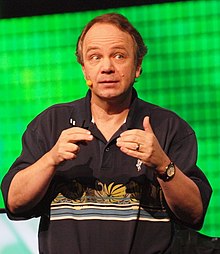Portal:Video games
Portal maintenance status: (April 2019)
|
The Video Games Portal

A video game, sometimes further qualified as a computer game, is an electronic game that involves interaction with a user interface or input device (such as a joystick, controller, keyboard, or motion sensing device) to generate visual feedback from a display device, most commonly shown in a video format on a television set, computer monitor, flat-panel display or touchscreen on handheld devices, or a virtual reality headset. Most modern video games are audiovisual, with audio complement delivered through speakers or headphones, and sometimes also with other types of sensory feedback (e.g., haptic technology that provides tactile sensations). Some video games also allow microphone and webcam inputs for in-game chatting and livestreaming.
Video games are typically categorized according to their hardware platform, which traditionally includes arcade video games, console games, and computer games (which includes LAN games, online games, and browser games). More recently, the video game industry has expanded onto mobile gaming through mobile devices (such as smartphones and tablet computers), virtual and augmented reality systems, and remote cloud gaming. Video games are also classified into a wide range of genres based on their style of gameplay and target audience. (Full article...)
Featured articles – load new batch
-
Image 1Flower is a video game developed by Thatgamecompany and published by Sony Computer Entertainment for the PlayStation 3. It was designed by Jenova Chen and Nicholas Clark and was released in February 2009 on the PlayStation Network. PlayStation 4 and PlayStation Vita versions of the game were ported by Bluepoint Games and released in November 2013. An iOS version was released in September 2017, and a Windows version was released in February 2019, both published by Annapurna Interactive. The game was intended as a "spiritual successor" to Flow, a previous title by Chen and Thatgamecompany. In Flower, the player controls the wind, blowing a flower petal through the air using the movement of the game controller. Flying close to flowers results in the player's petal being followed by other flower petals. Approaching flowers may also have side-effects on the game world, such as bringing vibrant color to previously dead fields or activating stationary wind turbines. The game features no text or dialogue, forming a narrative arc primarily through visual representation and emotional cues.
Flower was primarily intended to arouse positive emotions in the player, rather than to be a challenging and "fun" game. This focus was sparked by Chen, who felt that the primary purpose of entertainment products like video games was the feelings that they evoked in the audience and that the emotional range of most games was very limited. The team viewed their efforts as creating a work of art, removing gameplay elements and mechanics that were not provoking the desired response in the players. The music, composed by Vincent Diamante, dynamically responds to the player's actions and corresponds with the emotional cues in the game. Flower was a critical success, to the surprise of the developers. Reviewers praised the game's music, visuals, and gameplay, calling it a unique and compelling emotional experience. It was named the "best independent game of 2009" at the Spike Video Game Awards, and won the "Casual Game of the Year" award by the Academy of Interactive Arts and Sciences. (Full article...) -
Image 2
Roberta Lynn Williams (née Heuer; born February 16, 1953) is an American video game designer and writer, who co-founded Sierra On-Line with her husband, game developer Ken Williams. In 1980, her first game, Mystery House, became a modest commercial success; it is credited as the first graphic adventure game. She is also known for creating and maintaining the King's Quest series, as well as designing the full motion video game Phantasmagoria in 1995.
Sierra was acquired by CUC International in 1996, leading to layoffs and management changes. Williams took a brief sabbatical, and returned to the company in a game design role, but grew increasingly frustrated with CUC's creative and business decisions. After the release of King's Quest: Mask of Eternity in 1998, she left the game industry in 1999 and focused her retirement on traveling and writing historical fiction. In 2021 she released her historical novel, Farewell to Tara. Soon after, she returned to game development with the 3D remake of the classic adventure game Colossal Cave Adventure, released in January 2023 as Colossal Cave.
Several publications have named Roberta Williams as one of the best or most influential creators in the video game industry, for co-founding Sierra, pioneering the graphic adventure game genre, and creating the King's Quest series. Several publications have called her the "Queen of adventure games". She has received the Industry Icon Award from The Game Awards, and the Pioneer Award at the Game Developers Choice Awards. (Full article...) -
Image 3Grim Fandango is a 1998 adventure game directed by Tim Schafer and developed and published by LucasArts for Microsoft Windows. It is the first adventure game by LucasArts to use 3D computer graphics overlaid on pre-rendered static backgrounds. As with other LucasArts adventure games, the player must converse with characters and examine, collect, and use objects to solve puzzles.
Grim Fandango is set in the Land of the Dead and the retro-futuristic version of the 1950s, through which recently departed souls, represented as calaca-like figures, travel before they reach their final destination. The story follows travel agent Manuel "Manny" Calavera as he attempts to save new arrival Mercedes "Meche" Colomar, a virtuous soul, on her journey. The game combines elements of the Aztec afterlife with film noir style, with influences including The Maltese Falcon, On the Waterfront and Casablanca.
Grim Fandango received praise for its art design and direction. It was selected for several awards and is often listed as one of the greatest video games of all time. However, it was a commercial failure and contributed towards LucasArts' decision to end adventure game development and the decline of the adventure game genre. (Full article...) -
Image 4Sam & Max: Freelance Police was a graphic adventure video game developed by LucasArts from 2002 until its cancellation in 2004, and the final game in the company's adventure game era. Freelance Police was originally intended for release for Windows in early 2004 as a sequel to the 1993 title Sam & Max Hit the Road. The game was based on the characters Sam & Max: an anthropomorphic dog and "hyperkinetic rabbity thing" who debuted in a 1987 comic book series created by Steve Purcell. Freelance Police was announced in August 2002, and showcased at the Electronic Entertainment Expo (E3) in 2003. Like its predecessor, Freelance Police was designed as a point-and-click adventure game, but used a 3D game engine in place of the SCUMM and GrimE engines used in older LucasArts adventure games. The project's development was led by Michael Stemmle, one of the original designers for Sam & Max Hit the Road, while Steve Purcell assisted in developing the game's plot and providing artistic direction.
Although the game's development appeared to be proceeding towards completion without difficulty, LucasArts abruptly canceled production of Freelance Police in March 2004, citing economic and market conditions. The game's cancellation was received poorly by fans of the series, Steve Purcell, and the video game industry media. Many journalists viewed this move as a culmination in the decline of the adventure game genre. LucasArts later terminated its adventure game development, and many of the Freelance Police design team left to create Telltale Games and continue development of such adventure games. Steve Purcell moved the Sam & Max franchise to Telltale Games in 2005, prompting a revival of Sam & Max video games. (Full article...) -
Image 5Super Smash Bros. Melee is a 2001 crossover fighting video game developed by HAL Laboratory and published by Nintendo for the GameCube. It is the second installment in the Super Smash Bros. series. It features characters from Nintendo video game franchises such as Mario, The Legend of Zelda, Star Fox, Pokémon, and Donkey Kong among others. The stages and gameplay modes reference or take designs from these franchises as well.
Melee includes all playable characters from the first game and also adds characters from additional franchises such as Fire Emblem, of which no games had been released outside Japan at the time, in addition to new stages and gameplay modes. Like other games in the Smash Bros. series, Melee's gameplay system offers an unorthodox approach to the fighting game genre, with a counter that measures damage with increasing percentages, representing the knockback the character will experience, rather than the depleting health bar seen in most fighting games.
Melee was first released in Japan in November 2001, in the Americas in December 2001, and in Europe and Australia in May 2002. The game received widespread acclaim from critics, earning praise for its visuals, simple controls, gameplay, and orchestrated soundtrack, as well as several awards and acknowledgments from various publications; it is now considered one of the greatest video games ever made. It achieved strong sales upon its release, becoming the GameCube's best-selling title, with over seven million copies sold by 2008. Considered one of the most competitively viable Smash Bros. games due to its fast-paced and aggressive gameplay, Melee has been featured in many competitive gaming tournaments, boasting a dedicated grassroots fan community which has kept its competitive scene alive well beyond the game's original lifespan. It was followed by Super Smash Bros. Brawl for the Wii in 2008. (Full article...) -
Image 6Satoru Iwata (Japanese: 岩田 聡, Hepburn: Iwata Satoru, December 6, 1959 – July 11, 2015) was a Japanese businessman, video game programmer, video game designer, and producer. He was the fourth president and chief executive officer (CEO) of Nintendo from 2002 until his death in 2015. Iwata was a major contributor in broadening the appeal of video games by focusing on novel and entertaining games rather than top-of-the-line hardware.Iwata at Game Developers Conference in 2011
Born in Sapporo, Iwata expressed interest in video games from an early age and created his first simple game while in high school. He majored in computer science at the Tokyo Institute of Technology. In 1980, he joined the game developer HAL Laboratory while attending the university. At HAL, he worked as a programmer and closely collaborated with Nintendo, producing his first commercial game in 1983. Games to which he contributed include EarthBound and many games in the Kirby series. Following a downturn and near-bankruptcy, Iwata became the president of HAL in 1993 at the insistence of Nintendo president Hiroshi Yamauchi and brought financial stability. In the following years, he worked in the development of the Pokémon and Super Smash Bros. series. Iwata joined Nintendo as the head of its corporate planning division in 2000.
Nintendo saw growth under Iwata and, when Yamauchi retired, he became the company's president in May 2002. Under Iwata's direction, Nintendo developed the Nintendo DS and Wii game consoles, helping the company achieve financial success. As a self-declared gamer, he focused on expanding the appeal of video games across demographics through a "blue ocean" business strategy. Nintendo attained record profits by 2009, and Barron's placed Iwata among the top 30 CEOs worldwide. Iwata expanded his strategy by defining a quality-of-life product line for the Wii that evolved into a ten-year strategy to create standalone products. Later hardware such as the Nintendo 3DS and Wii U proved far less profitable than the Wii, and Nintendo's net sales fell by two thirds from 2009 to 2012; the company saw its first operating losses in 30 years during this time. Iwata voluntarily halved his salary in 2011 and again in 2014. In 2015, after several years of refusal, Iwata put a portion of Nintendo's focus into the rapidly growing mobile game market; a landmark partnership with mobile provider DeNA was established that March. Throughout his career, Iwata built a relationship with Nintendo fans through social media and his regular appearances in Iwata Asks and Nintendo Direct, becoming the public face of the company. (Full article...) -
Image 7Final Fantasy XII is a 2006 role-playing video game developed and published by Square Enix. The twelfth main installment of the Final Fantasy series, it was first released for the PlayStation 2 in March 2006. It introduced several innovations to the series: an open world; a seamless battle system; a controllable camera; a customizable "gambit" system, which lets the player control the artificial intelligence (AI) of characters in battle; a "license" system, which determines what abilities and equipment can be used by characters; and hunting side quests, which allows the player to find and defeat increasingly difficult monsters in the game's open world. Final Fantasy XII also includes elements from previous games in the series, such as Chocobos and Moogles.
The game takes place in Ivalice, where the empires of Archadia and Rozarria are waging an endless war. Dalmasca, a small kingdom, is caught between the warring nations. When Dalmasca is annexed by Archadia, its princess, Ashe, creates a resistance movement. During the struggle, she meets Vaan, a young adventurer who dreams of becoming a sky pirate in command of an airship. They are quickly joined by a band of allies; together, they rally against the tyranny of the Archadian Empire.
Final Fantasy XII was both a critical and commercial success, earning several Game of the Year awards and selling over six million copies on the PlayStation 2 by November 2009. In 2007, a sequel titled Final Fantasy XII: Revenant Wings was released for the Nintendo DS and, in that same year, an expanded version of Final Fantasy XII, titled Final Fantasy XII International Zodiac Job System, was released on the PlayStation 2 exclusively in Japan. A high-definition remaster of the International Zodiac Job System version, The Zodiac Age, was released worldwide for the PlayStation 4 in July 2017, for Windows in February 2018, and for the Nintendo Switch and Xbox One in April 2019. (Full article...) -
Image 8Portal is a 2007 puzzle-platform game developed and published by Valve. It was originally released in a bundle, The Orange Box, for Windows, Xbox 360 and PlayStation 3, and has been since ported to other systems, including Mac OS X, Linux, Android (via Nvidia Shield), and Nintendo Switch.
Portal consists primarily of a series of puzzles that must be solved by teleporting the player's character and simple objects using "the Aperture Science Handheld Portal Device", also referred to as the "portal gun", a device that can create intra-spatial portals between two flat planes. The player-character, Chell, is challenged and taunted by an artificial intelligence named GLaDOS (Genetic Lifeform and Disk Operating System) to complete each puzzle in the Aperture Science Enrichment Center using the portal gun with the promise of receiving cake when all the puzzles are completed. The Source Engine's physics system allows kinetic energy to be retained through portals, requiring creative use of portals to maneuver through the test chambers. This gameplay element is based on a similar concept from the game Narbacular Drop; many of the team members from the DigiPen Institute of Technology who worked on Narbacular Drop were hired by Valve for the creation of Portal, making it a spiritual successor to the game.
Portal was acclaimed as one of the most original games of 2007, despite some criticism for its short duration. It received praise for its originality, unique gameplay and a dark story and sense of comedy. GLaDOS, voiced by Ellen McLain in the English-language version, received acclaim for her unique characterization, and the end credits song "Still Alive", written by Jonathan Coulton for the game, was praised for its original composition and humor. Portal is often cited as one of the greatest video games ever made. Excluding Steam download sales, over four million copies of the game have been sold since its release, spawning official merchandise from Valve including a model portal gun and plush Companion Cubes, as well as fan recreations of the cake. (Full article...) -
Image 9Master Chief Petty Officer John-117, colloquially known as Master Chief, is the protagonist of the Halo video game series and its spin-off media. The character first appeared in the 2001 video game Halo: Combat Evolved, a science fiction first-person shooter that became a long-running franchise. The character also appears in spin-off Halo media such as the 2012 film Halo 4: Forward Unto Dawn, the 2022–2024 Halo television series, and several graphic novels and books.
The Master Chief is a towering supersoldier known as a "Spartan", trained from childhood for combat. The designers intended for players to be able to project their own intentions into the character and thus reduced his voiced lines and concealed his appearance under his armor. In the video games, the character is voiced by former disc jockey Steve Downes, who based his performance on Bungie's description calling for a man of few words, similar to Clint Eastwood. In spin-off media, he is portrayed by different voice and physical actors, most notably Pablo Schreiber on the 2022 live-action TV series.
A pop culture icon, Master Chief is widely regarded as one of the greatest video game characters of all time, with the character being seen as a mascot for Halo and the Xbox brand. His 2001 debut received a generally positive reception for his character design, with publications praising how the narrative allows players to inhabit the character, while others have criticized him as under characterized. In later Halo games developed by 343 Industries, the characterization of Master Chief earned praise for exploring his humanity and his relationship with Cortana. (Full article...) -
Image 10Star Control 3 is a 1996 action-adventure game developed by Legend Entertainment and published by Accolade. The third installment in the Star Control trilogy, the game was released for MS-DOS in 1996 and Mac OS in 1998. The story takes place after Star Control II, beginning with a disaster that disrupts superluminal travel through hyperspace. This leads the player to investigate a new quadrant of space, joined by allied aliens from the previous games.
The game features a single-player campaign that is similar to the previous installment, combining space exploration, alien dialogue, and ship-to-ship combat. As a mainstay of the series, the player engages in top-down battles between starships with unique abilities. In contrast to Star Control II, hyperspace flight is replaced with instantaneous fast travel. Planetary exploration is replaced with a colony management system, inspired by the original Star Control. Combat offers more detailed steering and aiming, as well as additional player-versus-player multiplayer options.
Accolade hired Legend Entertainment to create this sequel after the series creators Paul Reiche III and Fred Ford decided to pursue other projects. Legend was selected due to their passion for the previous Star Control games, as well as their experience as veteran game writers from the acclaimed adventure game studio Infocom. They designed the game in consultation with fans, replacing features from Star Control II that received negative feedback. Star Control 3 was considered a critical and commercial success upon release, with praise for its story and varied gameplay. However, the game later suffered from comparisons to the award-winning Star Control II, with a mixed legacy among both fans and critics. (Full article...)
Did you know... - show different entries
- ... that Kamibox's video game A Joke That's Worth $0.99 is permanently on special offer because Itch.io does not allow $0.99 as a regular price?
- ... that the 2005 video game Bokura no Kazoku was inspired in part by the birth of its creator's first child?
- ... that the character Psycho Mantis in the video game Metal Gear Solid breaks the fourth wall by identifying the player's other games?
- ... that the 1987 video game Oriental Hero was panned as "so incredibly bad it's almost worth a look"?
- ... that when Kaz Ayabe pitched his video game Boku no Natsuyasumi to Sony, he said that illustrator Mineko Ueda was interested in the project even though they had never actually met?
- ... that a pink skin for Mercy in the video game Overwatch helped raise more than $12 million for breast cancer research?
- ... that before Sarah Elmaleh voiced the player character in the video game Anthem, developed by BioWare, she voiced characters in a mod of an earlier BioWare game?
- ... that a version of the video game Rhino Rumble was not released due to the creators not wanting to add licensed characters?
- ... that Terra Invicta's development company is a group of former volunteer video game modders that decided to release their own game after the success of their mod?
- ... that the concept of adding strippers to the extreme sports video game BMX XXX was initially proposed in jest?
- ... that approximately 85 percent of Manhattan was recreated for the 2008 video game The Incredible Hulk?
- ... that the team developing the action video game Knights Contract researched European folklore on witches and witch hunts?
Selected biography – load new batch
-
Image 1Hironobu Sakaguchi (坂口 博信, Sakaguchi Hironobu, born November 25, 1962) is a Japanese game designer, director, producer, and writer. Originally working for Square (later Square Enix) from 1983 to 2003, he departed the company and founded independent studio Mistwalker in 2004. He is known as the creator of the Final Fantasy franchise, in addition to other titles during his time at Square. At Mistwalker, he is known for creating the Blue Dragon and Terra Battle series among several standalone titles, moving away from home consoles and creating titles for mobile platforms.Sakaguchi at the 2015 Game Developers Choice Awards
Originally intending to become a musician, he briefly studied electronics and programming, joining Square as a part-time employee, then later a full-time employee when Square became an independent company in 1986. He led the development of several titles before helping to create the original Final Fantasy, which proved highly successful and cemented his status within the company. Following the financial failure of Final Fantasy: The Spirits Within, his debut as a film director, Sakaguchi withdrew from Square's management and eventually resigned in 2003. He continued his game career through Mistwalker, first co-developing projects through external partners and then smaller in-studio mobile projects. (Full article...) -
Image 2
Todd Andrew Howard (born 1970) is an American video game designer, director, and producer. He serves as director and executive producer at Bethesda Game Studios, where he has led the development of the Fallout and The Elder Scrolls series. He was also the game director for Starfield. (Full article...) -
Image 3Carmack at the 2017 Game Developers Choice Awards
John D. Carmack II (born August 21, 1970) is an American computer programmer and video game developer. He co-founded the video game company id Software and was the lead programmer of its 1990s games Commander Keen, Wolfenstein 3D, Doom, Quake, and their sequels. Carmack made innovations in 3D computer graphics, such as his Carmack's Reverse algorithm for shadow volumes.
In 2013, he resigned from id Software to work full-time at Oculus VR as their CTO. In 2019, he reduced his role to Consulting CTO so he could allocate more time toward artificial general intelligence (AGI). In 2022, he left Oculus to work on his AGI startup, Keen Technologies. (Full article...) -
Image 4Molyneux at the University of Southampton in 2007
Peter Douglas Molyneux OBE (/ˈmɒlɪnjuː/; born 5 May 1959) is an English video game designer and programmer. He created the god games Populous, Dungeon Keeper, and Black & White, as well as Theme Park, the Fable series, Curiosity: What's Inside the Cube?, and Godus. In 2012 he founded and currently runs 22cans, a video game development studio.
In 2009, he was chosen by IGN as one of the top 100 game creators of all time. (Full article...) -
Image 5Yuji Naka (中 裕司, Naka Yūji, born September 17, 1965), credited in some games as YU2, is a Japanese video game developer. He is the co-creator of the Sonic the Hedgehog series and was the president of Sonic Team at Sega until his departure in 2006.
Naka joined Sega in 1984 and worked on games including Girl's Garden (1985) and Phantasy Star II (1989). He was the lead programmer of the original Sonic games on the Mega Drive in the early 1990s, which greatly increased Sega's market share. After developing Sonic the Hedgehog (1991) in Japan, Naka moved to California to develop Sonic the Hedgehog 2 (1992), Sonic the Hedgehog 3 (1994) and Sonic & Knuckles (1994) with Sega Technical Institute. (Full article...) -
Image 6Mitchell at a 2014 Twin Galaxies event
William James Mitchell Jr. (born July 16, 1965) is an American video game player. He achieved fame throughout the 1980s and 1990s by claiming numerous records on classic video games, including a perfect score on Pac-Man. Twin Galaxies and Guinness World Records recognized Mitchell as the holder of several records earned playing classic video games, and he has appeared in several documentaries on competitive gaming and retrogaming.
Mitchell rose to national prominence in the 1980s when Life included him in a photo spread of game champions during the height of the golden age of arcade video games. In 1999, Mitchell was the first person to claim a perfect score of 3,333,360 points on the arcade game Pac-Man. A 2007 documentary, The King of Kong: A Fistful of Quarters, follows his attempts to maintain the highest score on Donkey Kong after being challenged by newcomer Steve Wiebe. (Full article...) -
Image 7Satoshi Tajiri (Japanese: 田尻 智, Hepburn: Tajiri Satoshi, born August 28, 1965) is a Japanese video game designer and director who is the creator of the Pokémon franchise and the co-founder and president of video game developer Game Freak.
A fan of arcade games in his youth, Tajiri wrote for and edited his own video gaming fanzine Game Freak with Ken Sugimori, before evolving it into a development company of the same name. Tajiri claims that the joining of two Game Boys via a link cable inspired him to create a game which embodied the collection and companionship of his childhood hobby, insect collecting. The game, which became Pokémon Red and Pokémon Green, took six years to complete and went on to spark a multibillion-dollar franchise which reinvigorated Nintendo's handheld gaming scene. Tajiri continued to work as director for the Pokémon series until the development of Pokémon Ruby and Sapphire, when he changed his role to executive producer, which he holds to this day. (Full article...) -
Image 8Hiroshi Yamauchi (山内溥, Yamauchi Hiroshi, 7 November 1927 – 19 September 2013) was a Japanese businessman and the third president of Nintendo, joining the company on 25 April 1949 until stepping down on 24 May 2002, being succeeded by Satoru Iwata. During his 53-year tenure, Yamauchi transformed Nintendo from a hanafuda card-making company that had been active solely in Japan into a multibillion-dollar video game publisher and global conglomerate. He was the great-grandson of Fusajiro Yamauchi, Nintendo's first president and founder. Hiroshi Yamauchi owned the Seattle Mariners baseball team from 1992 until his death.
In April 2013, Forbes estimated Yamauchi's net worth at $2.1 billion; he was the 13th richest person in Japan and the 491st richest in the world. In 2008, Yamauchi was Japan's wealthiest person with a fortune at that time estimated at $7.8 billion. At the time of his death, Yamauchi was the largest shareholder at Nintendo. (Full article...) -
Image 9Tōru Iwatani (岩谷 徹, Iwatani Tōru, born January 25, 1955) is a Japanese video game designer who spent much of his career working for Namco. He is best known as the creator of the arcade game Pac-Man (1980). In 2009, he was chosen by IGN as one of the top 100 game creators of all time. (Full article...)Iwatani at the 2011 Game Developers Conference
-
Image 10Ken Kutaragi (久夛良木 健, Kutaragi Ken, born 2 August 1950) is a Japanese engineering technologist and businessman, currently president and CEO of Cyber AI Entertainment. Formerly the chairman and CEO of Sony Computer Entertainment (SCE), the video game division of Sony, Kutaragi is known as "The Father of the PlayStation" having overseen the development of the original console and its successors and spinoffs until departing the company in 2007, shortly after the PlayStation 3 was released.Kutaragi with his Lifetime Achievement Award at the Game Developers Choice Awards 2014
Kutaragi had also designed the sound processor for the Super Nintendo Entertainment System. With Sony, he designed the VLSI chip, which works in conjunction with the PS1's RISC CPU to handle the graphics rendering. (Full article...) -
Image 11Daigo Umehara (Japanese: 梅原 大吾, Hepburn: Umehara Daigo, born 19 May 1981) is a Japanese esports player and author who competes competitively at fighting video games. He specializes in 2D arcade fighting games, mainly those released by Capcom. Known as "Daigo" or "The Beast" in the West and "Umehara" (ウメハラ, written in katakana instead of kanji) or "Ume" in Japan, Daigo is one of the world's most famous Street Fighter players and is often considered its greatest. His longevity is seen as an incredibly rare thing in the world of competitive video games. He currently holds a world record of "the most successful player in major tournaments of Street Fighter" in the Guinness World Records and is a six time Evo Championship Series winner.
Before properly being called a pro gamer from signing a sponsorship deal with Mad Catz, Japanese media usually referred to Daigo as "the god of 2D fighting games" (2D格闘ゲームの神, 2D Kakutō Gēmu no Kami). (Full article...) -
Image 12
Gabe Logan Newell (born November 3, 1962), also known by his nickname Gaben, is an American video game developer and businessman. He is the president and co-founder of the video game company Valve Corporation.
Newell was born in Colorado and grew up in Davis, California. He attended Harvard University in the early 1980s but dropped out to join Microsoft, where he helped create the first versions of the Windows operating system. In 1996, he and Mike Harrington left Microsoft to found Valve and fund the development of their first game, Half-Life (1998). Harrington sold his stake in Valve to Newell and left in 2000. Newell led the development of Valve's digital distribution service, Steam, which launched in 2003 and controlled most of the market for downloaded PC games by 2011. (Full article...) -
Image 13
Ralph Henry Baer (born Rudolf Heinrich Baer; March 8, 1922 – December 6, 2014) was an American inventor, game developer, and engineer.
Baer's Jewish family fled Germany just before World War II and Baer served the American war effort, gaining an interest in electronics shortly thereafter. Through several jobs in the electronics industry, he was working as an engineer at Sanders Associates (now BAE Systems) in Nashua, New Hampshire, when he conceived the idea of playing games on a television screen around 1966. With support of his employers, he worked through several prototypes until he arrived at a "Brown Box" that would later become the blueprint for the first home video game console, licensed by Magnavox as the Magnavox Odyssey. Baer continued to design several other consoles and computer game units, including contributing to design of the Simon electronic game. Baer continued to work in electronics until his death in 2014, with over 150 patents to his name. (Full article...) -
Image 14
William Murray "Trip" Hawkins III (born December 28, 1953) is an American entrepreneur and founder of Electronic Arts, The 3DO Company, and Digital Chocolate. (Full article...) -
Image 15
Jordan Mechner (born June 4, 1964) is an American video game designer, author, screenwriter, filmmaker, and former video game programmer. A major figure in the development of cinematic video games and a pioneer in video game animation, he began his career designing and programming the bestselling 1984 martial arts game Karateka for the Apple II while a student at Yale University. He followed it with the platform game Prince of Persia five years later; it was widely ported and became a hit. Both games used rotoscoping, where actors shot on film by Mechner were drawn over to create in-game animation. Prince of Persia has become the basis for a long-running franchise, including a 2010 live-action film released by Walt Disney Pictures and an ongoing series of video games published by Ubisoft.
Mechner is the recipient of many accolades, including the 2017 GDC Pioneer Award. His works are often included in all-time lists of the game industry's best and most influential titles. (Full article...) -
Image 16
Raphael "Raph" Koster (born September 7, 1971) is an American entrepreneur, game designer, and author of A Theory of Fun for Game Design. Koster is widely recognized for his work as the lead designer of Ultima Online and the creative director behind Star Wars Galaxies. From 2006 until 2013 he worked as the founder and president of Metaplace (previously operating as Areae and acquired by social gaming company Playdom in 2010, which was in turn acquired by Disney) producing a Facebook game platform. (Full article...) -
Image 17Persson at the 2016 Game Developers Conference
Markus Alexej Persson (/ˈpɪərsən/ ⓘ PEER-sən, Swedish: [ˈmǎrːkɵs ˈpæ̌ːʂɔn] ⓘ; born 1 June 1979), also known as Notch, is a Swedish video game programmer and designer. He is the creator of Minecraft, which is the best-selling video game in history. He founded the video game development company Mojang Studios in 2009.
Persson began developing video games at an early age. His commercial success began after he published an early version of Minecraft in 2009. Prior to the game's official retail release in 2011, it had sold over ten million copies. After this point Persson stood down as the lead designer and transferred his creative authority to Jens Bergensten. In September 2014 Persson announced on his personal website that he had concluded he "[didn't have the connection to his fans he thought he had]", that he had "become a symbol", and that he did not wish to be responsible for Mojang's increasingly large operation. He left Mojang in November of that year, selling his company to Microsoft reportedly for US$2.5 billion. The acquisition made Persson a billionaire. (Full article...) -
Image 18Koji Kondo (Japanese: 近藤 浩治, Hepburn: Kondō Kōji, born August 13, 1961) is a Japanese composer and senior executive at the video game company Nintendo. He is best known for his contributions for the Super Mario and The Legend of Zelda series, with his Super Mario Bros. theme being the first piece of music from a video game included in the American National Recording Registry. Kondo was hired by Nintendo in 1984 as their first dedicated composer and is currently a Senior Officer at their Entertainment Planning & Development division. (Full article...)
-
Image 19
Nolan Kay Bushnell (born February 5, 1943) is an American businessman and electrical engineer. He established Atari, Inc. and the Chuck E. Cheese's Pizza Time Theatre chain. He has been inducted into the Video Game Hall of Fame and the Consumer Electronics Association Hall of Fame, received the BAFTA Fellowship and the Nations Restaurant News "Innovator of the Year" award, and was named one of Newsweek's "50 Men Who Changed America". He has started more than 20 companies and is one of the founding fathers of the video game industry. He is on the board of Anti-Aging Games. In 2012, he founded an educational software company called Brainrush, that is using video game technology in educational software.
He is credited with Bushnell's Law, an aphorism about games that are "easy to learn and difficult to master" being rewarding. (Full article...) -
Image 20Martinet at GalaxyCon Richmond 2024
Charles Andre Martinet (born September 17, 1955) is an American actor. Martinet is known for creating the voice of Mario in the Super Mario franchise, portraying him from 1991 to 2023. He also voiced other characters in the series such as Luigi, Wario, Waluigi, and the baby equivalents of Mario and Luigi, prior to stepping down as voice actor to become an official brand ambassador for the series.
Martinet is also known for his portrayal of Paarthurnax in 2011's The Elder Scrolls V: Skyrim, as well as Magenta in 2022's Dragon Ball Super: Super Hero. (Full article...) -
Image 21Meier at the 2010 Game Developers Conference
Sidney K. Meier (/ˈmaɪər/ MIRE; born February 24, 1954) is an American businessman and computer programmer. A programmer, designer, and producer of several strategy video games and simulation video games, including the Civilization series, Meier co-founded MicroProse in 1982 with Bill Stealey and is the Director of Creative Development of Firaxis Games, which he co-founded with Jeff Briggs and Brian Reynolds in 1996. For his contributions to the video game industry, Meier was inducted into the Academy of Interactive Arts and Sciences Hall of Fame. (Full article...) -
Image 22
Steven Scott Ritchie (born February 13, 1950) is an American pinball and video game designer. His career began in the 1970s. Ritchie holds the record for best-selling pinball designer in history. He has been called "The Master of Flow" due to the emphasis in his designs on ball speed, loops, and long smooth shots. Ritchie was also the original voice of Shao Kahn in the Mortal Kombat fighting game series, serving as the announcer of Mortal Kombat II (1993), Mortal Kombat 3 (1995), and the updates to Mortal Kombat 3. He is the older brother of fellow pinball designer Mark Ritchie. (Full article...) -
Image 23
Geoff Keighley (/ˈkiːli/ KEE-lee; born (1978-06-24)June 24, 1978) is a Canadian video game journalist and television presenter, best known for his role as the host of several video game industry conferences and presentations. He is the executive producer and host of the Game Awards since its inception in 2014, having previously served as the executive producer of the Spike Video Game Awards. He also hosts and produces Summer Game Fest, and has hosted live events for trades fairs Gamescom and the now-defunct E3.
He previously hosted the video game show GameTrailers TV, and G4tv.com. Keighley is also a freelance writer whose work has appeared in Kotaku among other publications. His multi-media series The Final Hours, originally an article series published by GameSpot, features in-depth interviews and behind-the-scenes with developers of popular franchises like Portal, Mass Effect and Tomb Raider. (Full article...) -
Image 24
Richard Allen Garriott (born 4 July 1961) is a British-born American video game developer, entrepreneur and private astronaut.
Garriott, who is the son of NASA astronaut Owen Garriott, was originally a game designer and programmer, and is now involved in a number of aspects of computer-game development. On October 12, 2008, Garriott flew aboard the Soyuz TMA-13 mission to the International Space Station as a private astronaut, returning 12 days later aboard Soyuz TMA-12. He became the second space traveler, and first from the United States, to have a parent who was also a space traveler. During his ISS flight, he filmed a science fiction movie Apogee of Fear. (Full article...) -
Image 25
James D. Rolfe (born July 10, 1980) is an American YouTuber, filmmaker, and actor. He is best known for creating and starring in the comedic retrogaming web series Angry Video Game Nerd (2004–present). His spin-off projects include reviews of retro films, television series, and board games. He is considered a pioneer of internet gaming videos and is noted for his widespread influence on YouTube content after the series premiered on the platform in 2006.
Rolfe began creating homemade video productions in the late 1980s, having made more than 270 videos and short films by 2004. Among these were the first Angry Video Game Nerd episodes (originally known as Bad NES Games, and later Angry Nintendo Nerd), which were released on his Cinemassacre website in 2004. Two years later, he gained mainstream attention when the series went viral after being published to YouTube. Following its success, Rolfe released a feature-length film based on the series in 2014, which received a mixed reception. (Full article...)
Selected image - show another
Recent video game-related events
- January 16, 2025 –
- Nintendo officially reveals the Nintendo Switch 2 video game console, the successor to the Nintendo Switch. (Nintendo)
- September 12, 2024 – 2023–2024 video game industry layoffs
- Microsoft announces that it will lay off 650 Microsoft Gaming employees as part of cuts to its workforce. (Variety)
- August 15, 2024 –
- American video game magazine Game Informer discontinues publication after 33 years. The magazine's website is also shut down. (BBC News)
Topics
Early history of video games (1947-1971) | |
|---|---|
| Analog and lightbulb games |
|
| Early Chess programs |
|
| Early mainframe games |
|
| First arcade games |
|
| People | |
| By platform | |
|---|---|
| By console generation | |
Video games by platform | |||||
|---|---|---|---|---|---|
| |||||
| Action |
| ||||||||||
|---|---|---|---|---|---|---|---|---|---|---|---|
| Action-adventure | |||||||||||
| Adventure | |||||||||||
| Digital tabletop | |||||||||||
| Puzzle | |||||||||||
| Role-playing | |||||||||||
| Simulation |
| ||||||||||
| Strategy | |||||||||||
| Other genres | |||||||||||
| Related concepts |
| ||||||||||
Video games by country | |
|---|---|
| Africa | |
| Americas | |
| Asia | |
| Europe | |
| Oceania | |
Best-selling video game hardware and software | |||||||||
|---|---|---|---|---|---|---|---|---|---|
| General | |||||||||
| Best-selling video games by platform |
| ||||||||
Video game concepts | |
|---|---|
| Attributes | |
| Characters | |
| Mechanics |
|
| Scenery | |
| Movement techniques | |
| Forms of play | |
| Game modes | |
Featured topics
Related portals
Categories
Things you can do
|
AfDs
Merge discussions
|
Other discussions
No major discussions
Good article nominations
DYK nominations
|
Articles that need...
| |
In other Wikimedia projects
The following Wikimedia Foundation sister projects provide more on this subject:
-
Commons
Free media repository -
Wikibooks
Free textbooks and manuals -
Wikidata
Free knowledge base -
Wikinews
Free-content news -
Wikiquote
Collection of quotations -
Wikisource
Free-content library -
Wikiversity
Free learning tools -
Wiktionary
Dictionary and thesaurus
- Pages using the Phonos extension
- Pages including recorded pronunciations
- Pages with Swedish IPA
- Portals with triaged subpages from April 2019
- All portals with triaged subpages
- Portals with no named maintainer
- Automated article-slideshow portals with 201–500 articles in article list
- Automated article-slideshow portals with less than 2 articles in article list
- Random portal component with over 50 available image subpages
- Pages using div col with small parameter
- Portals needing placement of incoming links
- Redirect targets of redirected portals with existing subpages




